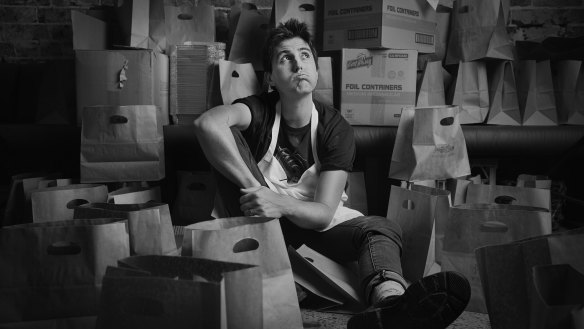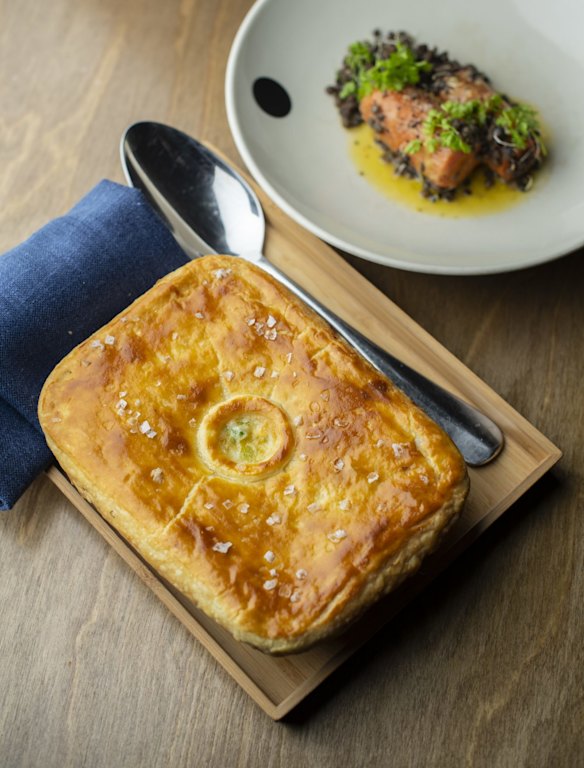Josh Niland takes stock on what it means to be a chef

- Restaurants 2.0: What kind of dining experience can we expect a year from now?
- Terry Durack reviews Mr Niland at Home
Valuable reflection during the lockdown has Josh Niland questioning everything that goes with eating out.
Josh Niland drops to the floor. Among neatly assembled lines of paper bags stamped with the Fish Butchery logo and boxes filled with takeaway food packaging, he sits with the kind of weight that suggests it's the first time he's been off his feet this week.

It's two days after Easter – two weeks since the federal government mandated the closure of all restaurant dining rooms and, like so many others, the chef has had to pivot his operations quickly to survive. His answer? Mr Niland At Home.
"By the end of the first week, after the government shut us all down, I had cooked 600 meals by myself," Niland tells me while photographer Rob Palmer shoots him among the stacks of unused packaging. "I was shattered. Last week it was 750, but now I've got all my chefs back, except for the two that had to go back home."
Transformation
The only thing that people want is to be cooked good, wholesome, proper food while enjoying company. I'm questioning all the silly noise that comes with that.Josh Niland
Except for the recognisable artwork hanging from the signature sandstone walls, there's not much to suggest we're sitting in the Saint Peter dining room. The tables have been removed and the windows, normally offering a view of Paddington, are papered over. Having been transformed by Niland into the base of operations for his takeaway initiative, it now churns out a different finish-at-home meal every night.
"That first week, I was doing the washing up at 1am before going home," says the chef, who together with his wife Julie and their three children also had to move house as the restaurant closures hit.
"Then I was back at 6am to start cooking again. But if that's what I have to do for two weeks to get everybody back at full wage, then I just have to do it."
"You get into a zone where you don't talk to anybody, you don't listen to anybody, you just stand and cook until your hands bleed. And they did. You do whatever you have to to make it work."
Among the strategies for success, paired with a desire to assist other chefs facing equally empty dining rooms, are the regular collaborations sprinkled throughout At Home's offerings.
Meals have to date included pasta from Cicciabella's Mitch Orr, ramen noodles from Keita Abe of Chaco Ramen, smoked pork jowl from LP's Quality Meats, and green curry by David Thompson.
Though borne of an unprecedented period of challenge for the hospitality industry, Niland, who is broadly hailed as a pescatarian prodigy, rising to fame as a champion of sustainable gill-to-fin dining, believes the government's enforced lockdown of restaurants as part of the broader COVID-19 restrictions has offered many in the industry (himself included) a valuable opportunity for reflection.
"It's brought a lot of perspective to the pretentious nature of being a chef and the ego involved in it," he says as Palmer, who also shot the images for Niland's Whole Fish Cookbook, fires off another round of photos.
"Do all those stupid, anal 'chef' things really matter when something like this happens?"
The project
Palmer and I have been spending the days following the government's announcement in the appropriately socially-distanced company of some of Sydney's best chefs, cataloguing the unique moment in history through the familiar eyes of Neil Perry, Matt Moran, Jacqui Challinor, Niland and their ilk.
The project, which will find its eventual home at the in-development Culinary Archive in Sydney's Powerhouse Museum, continues to document the complex effects the pandemic has had on the restaurant industry and those that work in it.
For Niland, these consequences include a deep introspection into not only the future of his business but the roots of his enthusiasm for it.
"There's a certain amount of damage that something like this does to your soul," Niland continues. "It cuts you in a place that you've never felt before. It's a little bit scarring. I don't feel the same anymore as I used to. I don't know what I'm meant to feel right now."
"Will we just flip back to being the kind of restaurant we were after this? Probably not. The only thing that people want is to be cooked good, wholesome, proper food while enjoying company. I'm questioning all the silly noise that comes with that."
A new market
Broadening his introspection are the new customers his At Home service has exposed him to.
"I'm engaged with a market that I've never seen before. There are people ordering our food that we've never talked to before, never had any interaction with, and they're getting really excited and repeat ordering.
"There's something about this kind of offering that's interesting as a road test to see other potential ideas."
He pauses as Palmer takes a few more photos, showing Niland the best of the flurry of shots when he's done.
"Maybe a restaurant where you sit down and you have a waiter talking to you, with all those overheads in labour, maybe that's not relevant anymore?"
As the photo shoot comes to an end, Niland stands and briefly reveals his socks, covered with a multitude of stitched fish.
"It's a bad situation and a very challenging one, but at the end of the day I get to cook 150 meals every day and then get messages saying how much people loved it. I'm very lucky."
Restaurant reviews, news and the hottest openings served to your inbox.
Sign up